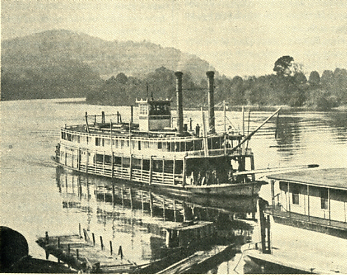
The Steamer H. K. Bedford at St. Mary's WV.
Click Here to Return to Milestones
In the past 10 years any number of rivermen have said they had heard of the nitroglycerin "blowup" at Georgetown; and I had notes of the various times I heard Capt. James Rowley describe it when I was steering for him 40 years ago, or more. I also recall hearing Capt. Gordon C. Greene tell about it, as I did the late Sandy Bivens, of Newport, Ohio, who was the purser on the Bedford.
The upper Ohio River country was still celebrating the election of William McKinley as president, over William Jennings Bryan, when this affair took place. At 4 p.m. the steamer H. K. Bedford left the Pittsburgh wharf with Capt. Gordon C. Greene, master; Capt. James H. Rowley, pilot; and Capt. Jesse R Hughes, not quite old enough to take his pilot's examination, as steersman. The date was Friday, November 6, 1896.
Capt. Rowley was on watch before supper, with Capt. Greene on until I I p.m. Capt. Rowley came on watch above Georgetown Island, came on down, and made the turn around the point below Georgetown. He did not see the skift tied up in the little bend below the fall of the hill at Mill Creek, and he pulled out a little to head down into Line Island.
When the waves went into the skiff, "away she went." Shipping glycerin by floating it down the river in a skiff was the safest way for the transporters, but not for others. The stuff was made in the hollow below Shannopin and loaded in skiffs there. This man got a late start that day, rowed along until night came on, then had tied up in that little bend, and had gone to bed in some farm house.
He never found the skiff. There was a big hole in the ground for a long time afterwards. The bare, yellow bank still stands 75 years later as mute evidence to the blast.
When I heard the explosion, I thought someone was celebrating the election. The Bedford was so close the bulkhead was blown down and fell on the bed that Capt. Greene had just got into, and he thought he was in a wreck, sure enough. Just then, Capt. Rowley saw a "hail" at Allens Landing, above Line Island. Some people got on but they were confused by the explosion; the people who got on at East Liverpool, Ohio, four miles below, said they had been in an earthquake.
That glycerin was going to Sistersville, WV, oil fields, and also to Belmont and Eureka. Another skiff load of it exploded at Parkersburg, WV, while going up little Kanawha, and nearly wrecked the old Jacob Heatherington, which was laid up there at the time.
Capt. Rowley's description of the happening was the same, with these additions: "The blast knocked me off my feet but fortunately didn't knock me unconscious. As I struggled up I grabbed the wire of the "stopping bell" and pulled myself up by the bellboard. My nose was bleeding and my ears roaring. When I got landed at Allen's, I went downstairs and found Capt. Greene sitting on the edge of the bed, with the wrecked bulkhead. "What happened, Rowley?" he drawled. "Our waves just upset a skiff of nitroglycerin," I replied.
"The explosion broke out windows eight or nine miles south of Georgetown at Hookstown, so you know what it did to the town. From Newell Bend, below East Liverpool, Ohio, clear up to Midland, PA, windows were shattered. A year or so later I was making a trip for someone on the then new Queen City (Phil Anschutz, maybe it was); and coming down into Line Island, flicked the searchlight on and saw a skiff down in the chute. I killed her out and managed to float past it, when a voice roared out: 'You better watch where you're going, you so-andso. There's nitroglycerin in this skiff!' Forever afterwards, in that stretch of river, I was always watching for a floating skiff, real or imaginary."
From the Waterways Journal, 1972
Article provided by Clyde Piquet
